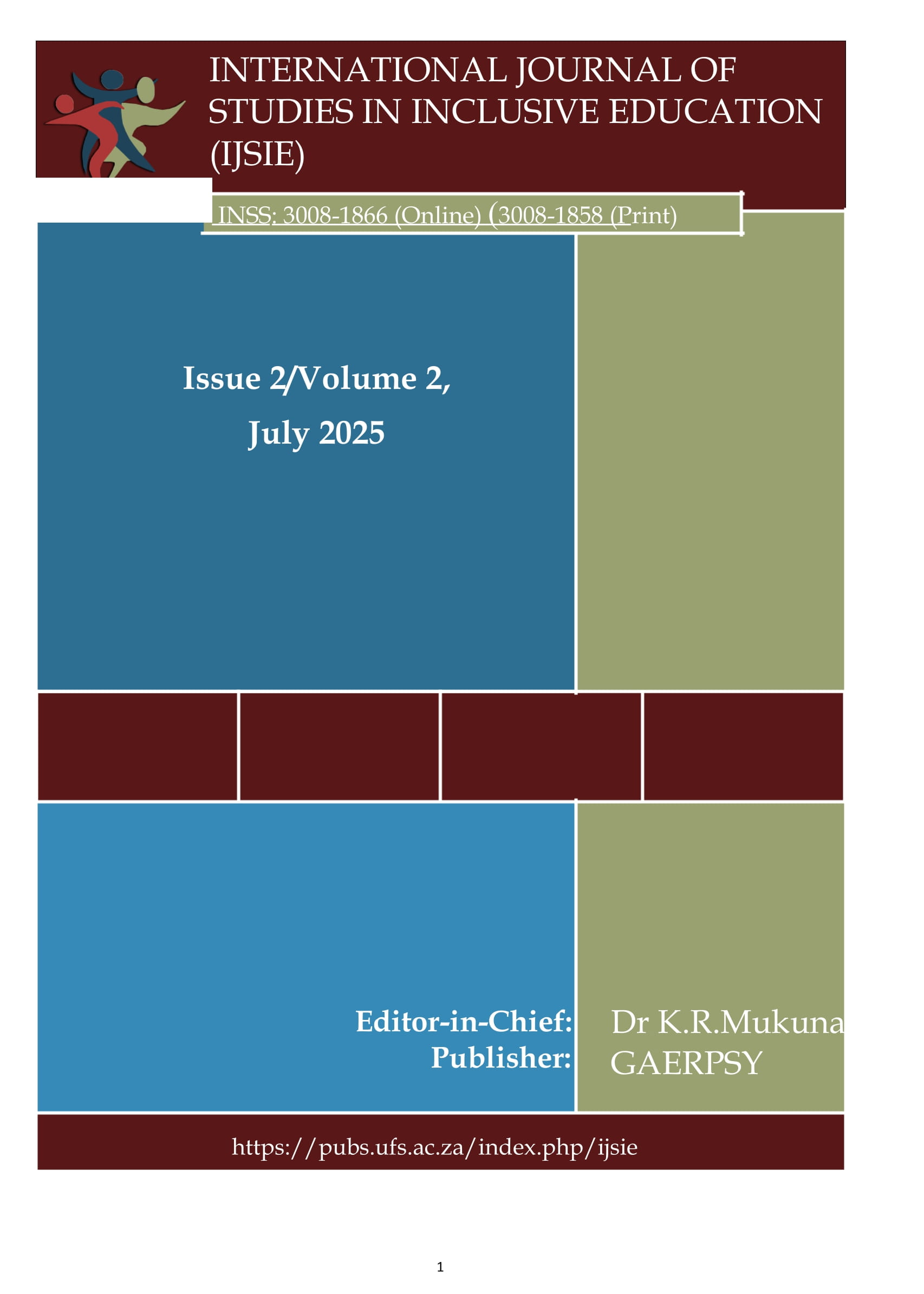Adapting trust-based relational intervention for students with autism spectrum disorder: A systematic qualitative review
DOI:
https://doi.org/10.38140/ijsie.v2i2.2099Keywords:
Autism spectrum disorder, Inclusive education, Neurodiversity, Sensory regulation, Trauma-informed care, Trust-based relational interventionAbstract
This systematic qualitative literature review examines the adaptation of trust-based relational intervention in supporting and caring for students with Autism Spectrum Disorder in educational settings. Fifteen peer-reviewed studies were identified and investigated using Braun and Clarke's reflexive thematic analysis. Three interconnected themes emerged from the review: personalised corrective techniques based on emotional safety, sensory empowerment techniques to help regulate emotions, and relational connection strategies tailored for individuals with autism spectrum communication styles. These revealed a growing movement for trauma-informed relationship therapy for students with autism spectrum disorders and flexible, neurodiverse treatments beyond typical behavioural approaches. This synthesis highlights that students require compassionate learning environments that respect individual communication and sensory preferences. These learning settings further reflect cultural diversity, respectively. It is recommended that future studies examine the long-term benefits of adapting Trust-Based Relational Intervention by investigating culturally grounded applications in various settings with a greater understanding of teachers' lived experiences in implementing trauma-informed relational models. Ultimately, this study contributes to creating inclusive and fair environments where students with autism are recognised, valued, and supported.
References
American Psychiatric Association (APA). (2022). Diagnostic and statistical manual of mental disorders (5th ed., text rev.). Washington, DC: American Psychiatric Publishing.
Anderson, J. M., & Smith, R. T. (2024). Adapting trauma-informed interventions for culturally diverse learners with autism. Journal of Multicultural Education, 18(1), 45–60. https://doi.org/10.1080/15595692.2023.1234567
Brown, H. L., & Nguyen, T. (2021). Sensory-informed behavior support plans for children with autism and trauma histories. Journal of Positive Behavior Interventions, 23(2), 90–102. https://doi.org/10.1177/1098300720913456
Bruce, S., & Nangle, D. W. (2021). Trauma-informed behavioral interventions for children with autism spectrum disorder: A review of the literature. Journal of Autism and Developmental Disorders, 51(7), 2375–2389. https://doi.org/10.1007/s10803-020-04678-3
Cross, T. L., Trach, J., & Garbutt, R. (2019). Sensory regulation interventions to support students with autism spectrum disorder: A systematic review. Journal of Child and Adolescent Psychiatric Nursing, 32(1), 3–14. https://doi.org/10.1111/jcap.12254
Faulkner, M. L., Johnson, C. A., & Bedard, C. (2023). Trauma-informed approaches in autism education: Adapting relational interventions for neurodiverse learners. Journal of Special Education Practice, 45(2), 101–117. https://doi.org/10.1177/00224669221112345
Goodall, S., Spencer-Smith, M., & Lawrence, K. A. (2025). Recommendations provided to families of neurodivergent children with histories of interpersonal trauma across two clinical assessment services within a major metropolitan children's hospital in Melbourne, Australia. Journal of Child & Adolescent Trauma, 18(4), 467–480. https://doi.org/10.1007/s40653-024-00684-9
Hwang, Y. S., & Kearney, P. (2017). Autism spectrum disorder and trauma: A systematic review of the literature. Journal of Autism and Developmental Disorders, 47(6), 1934–1948. https://doi.org/10.1007/s10803-017-3094-7
Kalisch, L. A., Lawrence, K. A., Baud, J., & Spencer-Smith, M. (2024). Therapeutic supports for neurodiverse children who have experienced interpersonal trauma: A scoping review. Review Journal of Autism and Developmental Disorders, 11, 733–755. https://doi.org/10.1007/s40489-023-00363-9
Kapp, S. K., Gillespie-Lynch, K., Sherman, L. E., & Hutman, T. (2013). Deficit, difference, or both? Autism and neurodiversity. Developmental Psychology, 49(1), 59–71. https://doi.org/10.1037/a0028353
Lambert, R., Kraus, L., & Finkelstein, A. (2021). Neurodiversity and trauma-informed education: Strategies for inclusive classrooms. International Journal of Inclusive Education, 25(10), 1120–1135. https://doi.org/10.1080/13603116.2020.1767556
Manuguid, H. M., & Catama, B. V. (2025). Adapting trust-based relational intervention with autism spectrum disorder: Exploring general education teachers' experiences. International Journal for Multidisciplinary Research, 7(3), 42615. https://doi.org/10.36948/ijfmr.2025.v07i03.42615
Martinez, A., & Greene, S. (2019). Sensory-friendly classrooms: Environmental supports for students with autism. Journal of Autism and Developmental Disorders, 49(4), 1722–1734. https://doi.org/10.1007/s10803-018-3759-1
Misevi??, M., Gervinskait? Paulaitien?, L., Lesinskien?, S., & Grauslien?, I. (2024). The impact of Trust-Based Relational Intervention (TBRI) on traumatized children: Meaningful change in attachment security and mental health after one year. Children, 11(4), 411. https://doi.org/10.3390/children11040411
Page, M. J., McKenzie, J. E., Bossuyt, P. M., Boutron, I., Hoffmann, T. C., Mulrow, C. D., ... Moher, D. (2021). The PRISMA 2020 statement: An updated guideline for reporting systematic reviews. BMJ, 372, n71. https://doi.org/10.1136/bmj.n71
Perry, B. D. (2006). Applying principles of neurodevelopment to clinical work with maltreated and traumatized children. In N. B. Webb (Ed.), Working with traumatized youth in child welfare (pp. 27–52). New York, NY: Guilford Press.
Pickett, E. (2023). Exploring the effectiveness and sustainability of Trust-Based Relational Intervention (TBRI®) as a trauma-informed approach in two Tasmanian child and family learning centers. Journal of Child & Adolescent Trauma. Advance online publication. https://doi.org/10.1007/s40653-023-00574-6
Ranjbar, P., Farnia, F., & Borjali, A. (2023). Trauma-informed care in special education: A review and future directions. Educational Psychology Review, 35(1), 43–64. https://doi.org/10.1007/s10648-022-09688-9
Schaaf, R. C., Benevides, T. W., Mailloux, Z., Faller, P., Hunt, J., van Hooydonk, E., & Kelly, D. (2018). Occupational therapy and sensory integration for children with autism spectrum disorder: A systematic review. American Journal of Occupational Therapy, 72(1), 7201190010p1–7201190010p11. https://doi.org/10.5014/ajot.2018.028431
Singer, J. (2016). Neurodiversity: The birth of an idea. In The neurodiversity reader (pp. 1–16). https://doi.org/10.1093/med/9780190209137.003.0001
Stevens, J. E., Popp, C., & Connors, C. M. (2020). Empowering regulation: Trauma-informed approaches for children with autism. Journal of Child and Family Studies, 29(2), 475–487. https://doi.org/10.1007/s10826-019-01541-9
Substance Abuse and Mental Health Services Administration. (2014). SAMHSA's concept of trauma and guidance for a trauma-informed approach. https://store.samhsa.gov/sites/default/files/d7/priv/sma14-4884.pdf
Taylor, S., & Graham, F. (2022). Implementing relational interventions for children with autism in mainstream classrooms: A qualitative study. Journal of Educational Psychology, 114(3), 657–670. https://doi.org/10.1037/edu0000567
van der Kolk, B. A. (2014). The body keeps the score: Brain, mind, and body in the healing of trauma. New York, NY: Viking.
Williams, K. M., & Patel, R. (2020). Trauma-sensitive classroom practices for children with ASD: A systematic review. Journal of School Psychology, 80, 99–112. https://doi.org/10.1016/j.jsp.2020.07.004
Young, E., & Roberts, A. (2019). The role of sensory regulation in trauma-informed education for students with autism. Behavioral Disorders, 44(4), 180–192. https://doi.org/10.1177/0198742919861721
Zhao, L., & Zhang, M. (2023). Neurodiversity and trauma-informed pedagogy: Strategies for enhancing relational safety in autism education. Journal of Autism and Developmental Disorders, 53(5), 2301–2314. https://doi.org/10.1007/s10803-022-05400-9
Additional Files
Published
How to Cite
Issue
Section
License
Copyright (c) 2025 Hilaria Manuguid

This work is licensed under a Creative Commons Attribution-NonCommercial-NoDerivatives 4.0 International License.
All articles published by GAERPSY Publishing are under an Attribution-NonCommercial-NoDerivatives 4.0 International (CC BY-NC-ND 4.0) license, allowing author (s) to share copies and redistribute the material in any medium or format. The GAERPSY Publishing cannot revoke these freedoms if they follow the license terms:
• Attribution: Author (s) must give appropriate credit, provide a link to the license, and indicate if changes were made. Author (s) may do so reasonably but not in any way that suggests the licensor endorses his/her or thier use.
• NonCommercial: Author (s) may not use the material for commercial purposes.
• NoDerivatives: If author (s) remixes, transforms, or builds upon the material, he/she (they) may not distribute the modified material.
• No additional restrictions: Author (s) may not apply legal terms or technological measures that legally restrict others from doing anything the license permits.








